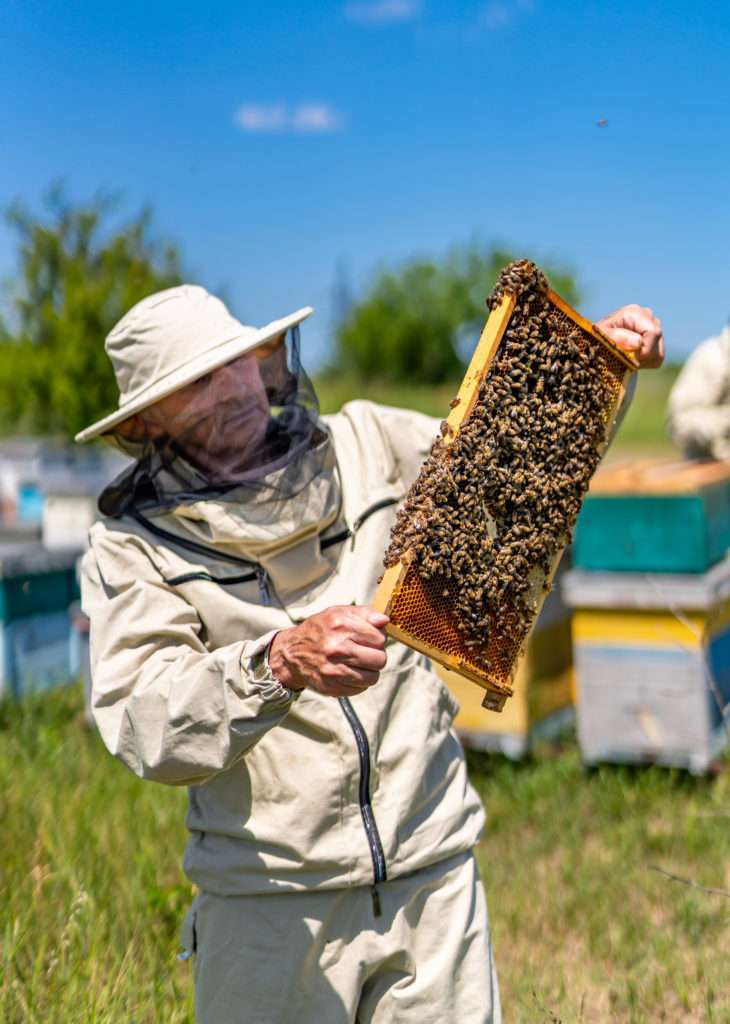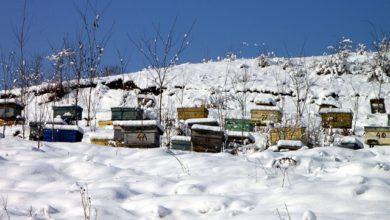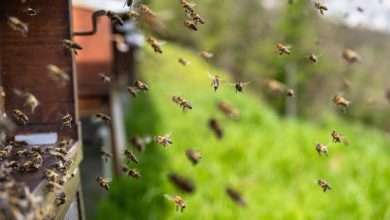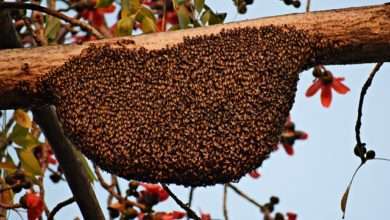Understanding the Threat: Beekeepers vs. Asian Yellow-Legged Hornets

I recently returned from traveling in Europe and found many beekeepers are facing a dangerous predator — the Asian yellow-legged hornet (Vespa velutina nigrithorax). The Asian yellow-legged hornet is native to east and southeast Asia, and has spread to Europe and now North America.
This invasive species is short-tempered, extremely predatory, and has a taste for honey bee larvae. In order to protect bees and other pollinators, beekeepers need to understand the threat posed by these hornets and develop strategies to control their spread.
The Asian yellow-legged hornet was first found in Europe in 2004, marking the first sighting in Western Europe. The species has since spread and established itself in both France and Spain.
The rapid spread of the species is believed to be linked to human commerce, from imported shipments of ornamental plants or fruit.
In the United States, the first confirmed sighting of the Asian yellow-legged hornet was in 2017 in Washington State. The species has since been established in both the Pacific Northwest and California.
The expanding range of the Asian yellow-legged hornet in the US is likely due to the increase in international trade, as well as the warming climate. The hornets can survive in temperatures as low as 35F, and as high as 100F, allowing it to thrive in multiple climates.
Understanding Asian Yellow-Legged Hornets
- Physical Characteristics and Identification
The Asian Yellow-Legged Hornet, scientifically known as Vespa velutina, is a species of hornet native to Southeast Asia. It measures around 2.5 to 3 centimeters in length, with a distinct yellow coloration on its legs, hence its name. Its body is primarily dark brown or black, adorned with a characteristic yellow-orange band on its abdomen. This color pattern assists in distinguishing it from other hornet species.
- Native Habitat and Distribution
Originally found in regions of Asia, particularly in the areas of China, Taiwan, and parts of India, the Asian Yellow-Legged Hornets have recently spread to several countries in Europe. Due to accidental transport through imported goods or commercial shipping, they have now established populations in Spain, Portugal, France, Italy, Germany, and the United Kingdom. This invasive species adaptability to different conditions has facilitated its successful colonization in these new territories.
- Life Cycle and Behavior
Asian Yellow-Legged Hornets possess a distinctive life cycle, which starts with the hibernation phase during the winter months. In spring, the queen hornets emerge from hibernation to find a suitable location for their nests. They commonly build their nests within tree cavities, but can also be found in sheds, roof spaces, and other human-made structures. At this stage, the queen begins laying eggs, establishing a workforce of workers to expand the colony.
As the colony develops, the hornets venture further from their nests in search of food, which primarily consists of nectar, tree sap, and other insects. It is during this time, usually in late summer and early autumn, that the hornets become more aggressive and may pose a threat to humans. They are known to defend their nests vigorously if they feel threatened, presenting a potential danger to those who unknowingly approach their vicinity.
Hornets’ Predation on Honeybees
One of the most concerning aspects of Asian Yellow-Legged Hornets’ presence is their predation on honeybees. These hornets are highly skilled hunters, capable of capturing and killing large numbers of honeybees in a short span of time.
The hornets target honeybees as a food source for their own colonies, making them a relentless threat to bee populations.
Destruction of Beehives and Potential Economic Losses
As Asian Yellow-Legged Hornets invade beehives, they wreak havoc on the delicate structures. These hornets are known for their destructive behavior, systematically dismantling beehives and causing significant damage.
Their presence can consequently lead to the loss of entire beehives, resulting in substantial economic losses for beekeepers.
Weakening of Honeybee Populations and Implications for Pollination
The predatory behavior of Asian Yellow-Legged Hornets has severe implications for honeybee populations and, consequently, for the process of pollination. With their relentless attacks, these hornets weaken honeybee colonies, making them more susceptible to diseases and other threats.
As a result, honeybee populations decline, compromising their ability to perform their vital role as pollinators. This decline has far-reaching consequences for the ecosystem, agricultural yields, and food security.
Beekeeper Strategies to Combat Asian Yellow-Legged Hornets
With their aggressive nature and ability to decimate entire colonies, it is crucial for beekeepers to be equipped with effective strategies to combat these invasive pests. Here are four key tactics that beekeepers can employ to tackle the Asian Yellow-Legged Hornets and safeguard their bee colonies.
- Early Detection and Monitoring
One of the most fundamental steps in combating Asian Yellow-Legged Hornets is early detection. Regular monitoring of hives and surrounding areas is vital to identify the presence of these predatory hornets swiftly.

Beekeepers should be vigilant for telltale signs such as increased activity, disrupted hive patterns, or the sight of individual hornets near hives. By actively observing and spotting them at an early stage, beekeepers can significantly minimize the potential damage caused by these hornets.
- Installation of Hornet Traps and Bait Stations
Another effective strategy for preventing Asian Yellow-Legged Hornets’ attacks on beehives is installing specially designed hornet traps and bait stations. These traps lure the hornets using attractive scents, pheromones, or other enticing substances, effectively trapping them while ensuring minimal harm to beneficial insects like honeybees.
Regularly emptying, cleaning, and relocating the traps can enhance their effectiveness, significantly reducing the number of hornets in the vicinity of the beehives.
- Protective Measures for Beehives
To safeguard honeybee colonies from Asian Yellow-Legged Hornets, beekeepers must implement various protective measures. Firstly, maintaining strong and sturdy hives with well-fitting entrance reducers can make it more challenging for hornets to penetrate the colonies.
Additionally, installing wire-mesh screens over hive entrances helps further deter hornets while ensuring adequate ventilation for the bees. Regular inspection and repair of hive structures can help in identifying vulnerabilities and taking timely corrective action to fortify the colonies against potential attacks.
- Collaborative Efforts and Information Sharing:
Combating Asian Yellow-Legged Hornets requires collective action from beekeepers, authorities, and other relevant stakeholders. Establishing strong collaborative networks and sharing critical information is essential to stay updated on the presence and movements of these invasive pests.
Beekeeping associations, research institutions, and local authorities should encourage and facilitate open communication channels and organize educational programs to ensure beekeepers are equipped with the latest knowledge and strategies to combat the Asian Yellow-Legged Hornets effectively. Regular workshops, webinars, and conferences can serve as valuable platforms to exchange experiences, best practices, and successful interventions.
Government and Community Involvement in Combating Asian Yellow-Legged Hornets
In the fight against the invasion of Asian Yellow-Legged Hornets, government and community involvement plays a crucial role. Local and national governments, in partnership with beekeepers and the general public, have implemented various strategies to combat this invasive species.
The Role of Local and National Governments
Government entities have recognized the severity of the Asian Yellow-Legged Hornet invasion and have actively engaged in combating it. These governments play a key role in coordinating efforts, enacting policies, and providing necessary resources to address the issue on both local and national scales. They focus on establishing comprehensive frameworks that enable efficient and coordinated actions against this invasive species.
- Coordination and Collaboration: Local and national governments work together to establish efficient coordination mechanisms. This involves assembling task forces or specialized teams dedicated to monitoring and controlling Asian Yellow-Legged Hornets. By fostering collaboration between different jurisdictions, governments can facilitate the exchange of information, resources, and expertise to combat the invasive hornets effectively.
- Policy Development: Governments play a crucial role in the development and implementation of policies that target the Asian Yellow-Legged Hornets. These policies focus on aspects such as surveillance and monitoring programs, reporting mechanisms, and the regulation of the movement of goods and equipment that may inadvertently aid in the spread of these invasive pests.
Efforts to Raise Awareness and Educate Beekeepers and the General Public
Raising awareness and educating beekeepers and the general public are crucial steps in combating the Asian Yellow-Legged Hornets. By increasing knowledge and understanding, individuals can contribute to the efforts and take necessary precautions to prevent the spread of these invasive species.
- Awareness Campaigns: Government agencies collaborate with experts and beekeeping associations to launch awareness campaigns. These campaigns aim to inform the public about the risks associated with Asian Yellow-Legged Hornets and the potential impact on the ecosystem. They also emphasize the importance of early detection, reporting sightings, and implementing preventive measures.
- Training and Workshops: To equip beekeepers with the necessary knowledge and skills to combat Asian Yellow-Legged Hornets, governments organize training sessions and workshops. These sessions cover topics such as hornet identification, nest destruction techniques, and protective measures. By empowering beekeepers, governments ensure their active participation in controlling the spread of these invasive pests.
Funding and Research Initiatives:
Governments recognize the need for adequate funding and research to develop effective control strategies against Asian Yellow-Legged Hornets. By investing in targeted initiatives, they support scientific endeavors to better understand the pests’ behavior, develop sustainable control methods, and enhance overall preparedness.
- Financial Support: Government funding is allocated to support research projects, surveillance programs, and the implementation of control measures. This financial backing enables scientists, experts, and beekeepers to collaborate and develop innovative strategies to combat the Asian Yellow-Legged Hornets.
- Research Partnerships: Governments actively seek partnerships with research institutions, universities, and beekeeping associations to conduct studies on Asian Yellow-Legged Hornets. Such collaborations aim to investigate the pests’ biology, behavior, and ecological impact, providing crucial insights that inform the development of effective control strategies.
Conclusion
The Asian yellow-legged hornet is an increasingly concerning threat to beekeepers and honeybees all over the world. The species is highly dangerous and is capable of decimating entire honeybee colonies in a matter of hours.
In order to protect bees and other pollinators, beekeepers need to understand the threat posed by these hornets and develop strategies to control their spread. Such strategies include controlling the movement of the species, bolstering the resilience of honeybee colonies, and using traps to reduce the population of the hornets. With the proper steps taken, beekeepers can ensure that their honeybee colonies remain safe and healthy.
Frequently Asked Questions
What is the Asian Yellow-Legged Hornet, and why is it a threat to beekeepers?
- The Asian Yellow-Legged Hornet (Vespa velutina) is an invasive species detrimental to honeybees and other pollinators. It preys on honeybees, decreases honey production, and poses a significant threat to beekeeping operations.
How can I identify an Asian Yellow-Legged Hornet?
- Asian Yellow-Legged Hornets are generally larger than common European hornets, typically measuring between 1 and 1.5 inches in length. They are characterized by their velvety black or dark brown bodies, bright yellow legs, and an orange-yellow strip on their abdominal segment.
Why is it important for beekeepers to understand the threat posed by Asian Yellow-Legged Hornets?
- Beekeepers need to be aware of the threat Asian Yellow-Legged Hornets pose in order to take appropriate measures to protect their colonies. These hornets are highly efficient predators of honeybees, potentially causing severe damage to bee populations and, consequently, affecting honey production and pollination services.
Can Asian Yellow-Legged Hornets be controlled or eradicated?

- While complete eradication of Asian Yellow-Legged Hornets may be challenging, control measures can be implemented to minimize their impact. Early detection, nest destruction, and targeted trap use can help manage their numbers and limit their damage to honeybee colonies.
Are there any specific signs of Asian Yellow-Legged Hornet activity near beehives?
- Yes, signs of Asian Yellow-Legged Hornet activity around beehives may include frequent attacks on bees at hive entrances, visible damage to honeybee colonies, and increased bee mortality. Additionally, it is not uncommon to find their distinctive football-shaped nests constructed in trees or buildings.
How can beekeepers protect their colonies from Asian Yellow-Legged Hornets?
- Beekeepers can implement various protective measures such as installing hornet-proof hive entrances, using trapping systems designed specifically for Asian Yellow-Legged Hornets, and regularly inspecting hives for signs of infestation or predation.
Is there a specific time of year when Asian Yellow-Legged Hornets are more active?
- Asian Yellow-Legged Hornets are most active during the late summer and early autumn months when their colonies reach peak population sizes. This is a crucial time for beekeepers to be vigilant and take preventive actions to protect their hives.
What should I do if I suspect Asian Yellow-Legged Hornets are present near my beehives?
- If you suspect the presence of Asian Yellow-Legged Hornets near your beehives, it is essential to report sightings to your local beekeeping association, agricultural authority, or relevant entomological experts. They can provide guidance, resources, and support to help assess the situation and implement appropriate control strategies.




